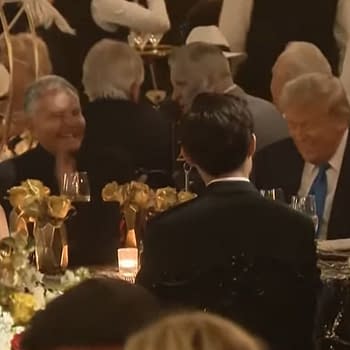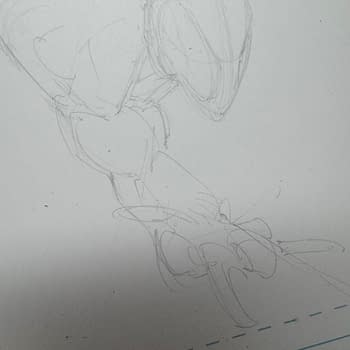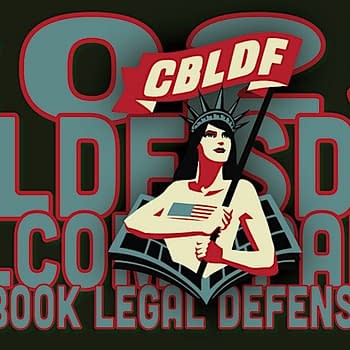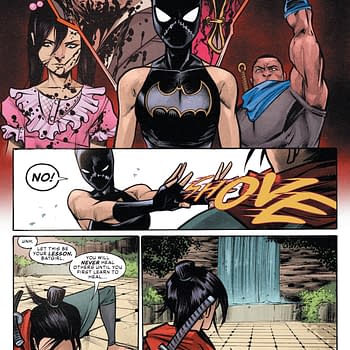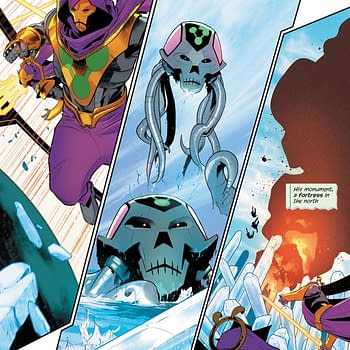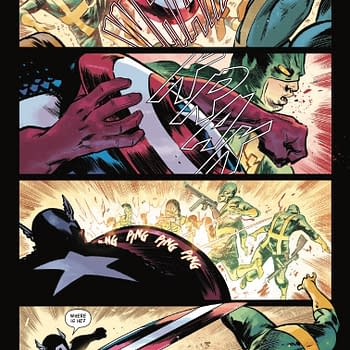Posted in: Comics, Look! It Moves! by Adi Tantimedh, Recent Updates | Tagged: Comics, games, horror, novels, saw
Look! It Moves by Adi Tantimedh #122: A Black Light Hallowe'en Special
In the spirit of Halloween, here's something a bit different.
BLACK LIGHT is a horror novel about Buck Carlsbad, a detective with a particular psychic power: he exorcises ghosts by eating them. This is not an ability that makes for a particularly happy life, and while he tries to trace his family to find out why or how he came to have this power, he ends up in the last situation he ever wanted to be in, trapped on a speeding train travelling across the site of one of the worst supernatural outbreaks in America, with a trainload of prospective victims for a particularly nasty entity.
BLACK LIGHT is a unique entry in the genre of supernatural detective thrillers in the same territory as Jim Butcher's HARRY DRESDEN series, Richard Kadrey's SANDMAN SLIM series, John Shirley's BLEAK HISTORY Clive Barker's Harry D'amore or, of course, John Constantine.
BLACK LIGHT comes with a particular pedigree: the three authors have form in recent horror films. Marcus Dunstan and Patrick Mellon are the writers of the SAW movie series and Stephen Romano is the writer of Don Coscarelli's adaptation of Joe Lansdale's INCIDENT ON AND OFF A MOUNTAIN ROAD for MASTERS OF HORROR and the upcoming BUBBA NOSFERATU.
I had a chance to speak to Marcus, Patrick and Stephen at New York Comic Con where they were promoting the novel. We spoke for more than an hour about the horror genre and horror movies in general for a longer interview that will run sometime in the future, but in the meantime, here's our discussion about their debut novel.
So the first question is what made you guys decide to write a horror novel?
Romano: It was all their idea.
Mellon: Well, it start as a script that he (Marcus) and I did after we wrote FEAST, and we liked the idea of this character that has these paranormal abilities and he's on a train. The thing is, at that time, horror movies changed abruptly to the HOSTELs and SAWs. We'd just come out of the J-Horror movies, so us talking about a ghost story, no one wanted to hear it, because they thought it was no 'in' anymore. So we put that aside and we met this editor named John Schoenfelder. He was part of Little.Brown and doing these genre novels and was looking for horror stuff. We had this idea and he really sparked to it. In order to make it into a novel, he hooked us up with Stephen (Romano) who has a history in that, and that's where it all began. We just had some characters and locations and Stephen came In with a ton of ideas.
Romano: We were on the phone, John Schoenfelder and I. We threw ideas at them in one big breath and they waited for us to finish talking and went, "Wow, that's cool! Great!" And we were off. It was a great give-and-take."
So what was it like for three people to write prose together? It's a different dynamic from writing a screenplay with another person. How did you guys divide the labour?
Marcus: Patrick and I had developed a bit of a world and a skillset, a bit of a character. The format of the novel allows you to do something that a screenwriter can't in exploring the inner voice and breaking the reigns of what would usually have to be the 90-minute thrill-ride. A horror-thriller film usually has to come in at that running time whereas a novel doesn't need to stop at 300 pages, you can keep going until you run out of breath.
Romano: This was a personal story for each of us, our childhood trepidation about death and the wonderment of the supernatural. Each of us having clocked in over 30-plus years of life, combine those to the wisdom of an old man and filter that through Buck Carlsbad, our lead character, and giving him a terrifying but hopeful journey into the dark to shed new light, in this case, a black light. It was collaboration between the three of us and the editor. Versions going back and forth and finding the best way to tell it, we're used to that.
Marcus: Stephen wrote the first MASTERS OF HORROR episode under similar pressures to get something done in a short period of time, so we all knew how to play nice together. The best idea always wins out, so when you have four voices talking, it had to be pretty rock-solid without one of us calling bullshit, you know?
Romano: I couldn't ask for a smoother ride.
You don't get the feeling reading the book that it's three people working together. It all holds together quite nicely and feels unified.
Patrick: John talked to us about bringing in another person and –
Was there trepidation?
Patrick: We needed someone we could mesh with, and we grew up in the same era and had the same sensibilities.
Marcus: Tell him about Don Dokken.
Patrick: Right. Don Dokken used to live down the street in a really nice manicured block, and then there was this house with these completely overgrown wrought-iron fences, painted black, holes in the ceiling that someone just put plywood over to cover it up, and a dirty-black Jaguar in the driveway. He was Dokken. We just thought it was the coolest thing.
Romano: I love 1980s Hair Rock, so that became Buck's favourite music.
Marcus: The weirdest thing is we referenced a specific song, I don't want to call it his theme song, we didn't really quote the lyrics or anything, we had a thing in there where he was obsessed with this particular song by Warrant.
Romano: It's a kitsch-y thing. The guy who wrote that song, Jani Lane, died less than two months before our book came out. It's almost enough to make you believe in ghosts.
Patrick: It's like Stephen killed him.
Romano: I was like, "Did you guys hear about that? It's so weird!"
I really don't think Jani Lane was a horrible songwriter. A lot of people will think you're really brave for doing that, the rest of them will go, "Err, whatever", right? But I was sincere for my admiration for that music.
Patrick: Weren't you in a Hair Rock band?
Romano: I was! Can't you tell? I had the full-on Nikki Sixx 'do back then. We made Buck an appreciator of something out of time, something that would make people go "Uuurgh" and roll their eyes at, because it makes him work harder in a world that doesn't understand him at all.
Right, but it's from his childhood, isn't it?
Patrick: It's something he can't really let go of. He can't let go of his past.
Romano: He listens to a Walkman with a tape in it. These are the things we kicked around as boomers and worked them into the story In ways that were interesting and quirky.
Patrick: Any movie we worked on, at some point Marcus will turn around and say, "Hey, let's set this in the 80s!" "Why would we do that?" "It's cool!"
Marcus: How do we solve the cellphone issue? Put it in the 80s!
Patrick: Or just have it say "No signal".
I wanted to ask you about the theme of the book. While it's true that in horror movies, things are in the gore end right now, in horror novels and television, there's a lot of supernatural stuff, especially about people who can see ghosts and deal with them. It seems to be big in the zeitgeist now, and it strikes me that there's an existential theme in there – whenever you're dealing with ghosts, you're dealing with loss and mortality, and Buck is somebody who suffered a huge loss. You have this engine of Buck's mission, which becomes intensified because he's stuck on a train with that stuff. Were you guys conscious of this going in? CBS has not gone without a TV series about someone who sees ghosts for nearly a decade now, and we have GHOST HUNTERS on SyFy. It's good that you guys came up with an edgier take on the subject.
Marcus: Part of it is a reaction to what has been placating people's sensibilities on television, and the other drive was to address that issue in a more aggressive way, and it was nice to take a character that had wandered in from a dark corner of our imagination and have him bleed, have him fight, and ultimately have it wrapped in that enigma that is the afterlife, that is beyond, is an idea of hope that there's a place to go when our eyes close for the last time.
Patrick: It's funny you referenced THE GHOST WHISPERER, because we were all very aware of that. We had that conversation with John and he was talking about that. The shows are always shot through a gentle Lifetime Movie feel. Our tastes are really the opposite. There's nothing beautiful about what Buck is doing. It's painful. It's disgusting. This is our pulpy take on that whole subgenre.
Romano: The reason I was attracted to the project was because Buck literally ingests ghosts and regurgitates them, pukes them into urns. When I heard that, I thought, "I have to work on it!" It was the coolest thing I ever heard. It's like some weird Texas version of Ghostbusters where I'm chewing tobacco, it's kind of where we're coming from. The whole idea is taking these old chestnuts and putting them in a new roaster.
I think the Japanese would love that idea, because the Japanese and Asians have a different relationship with the supernatural. Asian culture takes the supernatural much more for granted more than Western culture does.
Patrick: My wife is Chinese, and way back, she had one of the original ideas for what this character can do. When he began, he had a black head of hair, and everytime he ingests a ghost, one of those white hairs turns white.
That's very Asian.
Patrick: A pretty neat visual. So the first time he does it, that happens, and when we catch up with him later in life, his hair is half-white and half-black.
Romano: He's not even 40 and he's got streaks of grey hair for every ghost that he ingested.
Patrick's it's completely inspired by those Asian movies.
It's a folkloric thing. The basic metaphor is about the price you pay for dealing with the supernatural. You don't come out of this unscathed. You have to give something up.
Patrick: It's an interesting irony in that he's doing this thing and going into the black by trying to find the story of this life and what happened to his parents, but everytime he does it, he's killing himself. It's not beautiful and lovely Jennifer Love-Hewitt.
Romano: He himself is a flawed person. He's so out of step with reality and he carries a Walkman around. He can't really love anybody. He doesn't really know what love it. There are many representations of that. There's a woman who really loves him in the beginning and he can't really give love back. He runs into another woman later who's kind of like him. She has some of the powers he has and he relates to her but it's still very scary. Buck is now a man out of time, he's a man kind of without a country. There's a feeling he's lost, like a ghost. As a result, we try to keep the prose very lean, so that you know that about him, how he's drifting through this thing and coming to a crossroads in his life to fill in all the holes.
Marcus: It's what this book is about. It's about him becoming human again in a sea of ghosts.
He's also like a callback to the archetype of Chiron, the wounded healer who can only heal himself by healing others.
Romano: Yes. By turns he is a despicable guy and he's also a great guy. He's one of the most honest spirit hunters you're going to find. In our mythology, there are a lot of ghost hunters and many of them are crooks – they will lie to you when their rent is due. Buck doesn't do that because he knows not only is it bad for your karma but it's not good for word-of-mouth either.
So are you guys planning on more novels about Buck?
Marcus: That was initially the idea. The idea was establishing him in the way that we do – we spend a lot of time in the first hundred pages in the world of rules with the idea that he would go on to do this again and again, so the train story is just his latest adventure.
Patrick: I think it depends on what the reaction to this book will be. Do they want another one?
Marcus: if book sales are decent, we'd be thrilled to do that.
BLACK LIGHT is now available in bookshops.
(Thanks to Miriam Parker at Mulholland Books)
Sensing ghosts at lookitmoves@gmail.com
Follow the official LOOK! IT MOVES! twitter feed at http://twitter.com/lookitmoves for thoughts and snark on media and pop culture,
stuff for future columns and stuff I may never spend a whole column writing about.
Look! It Moves! © Adisakdi Tantimedh








